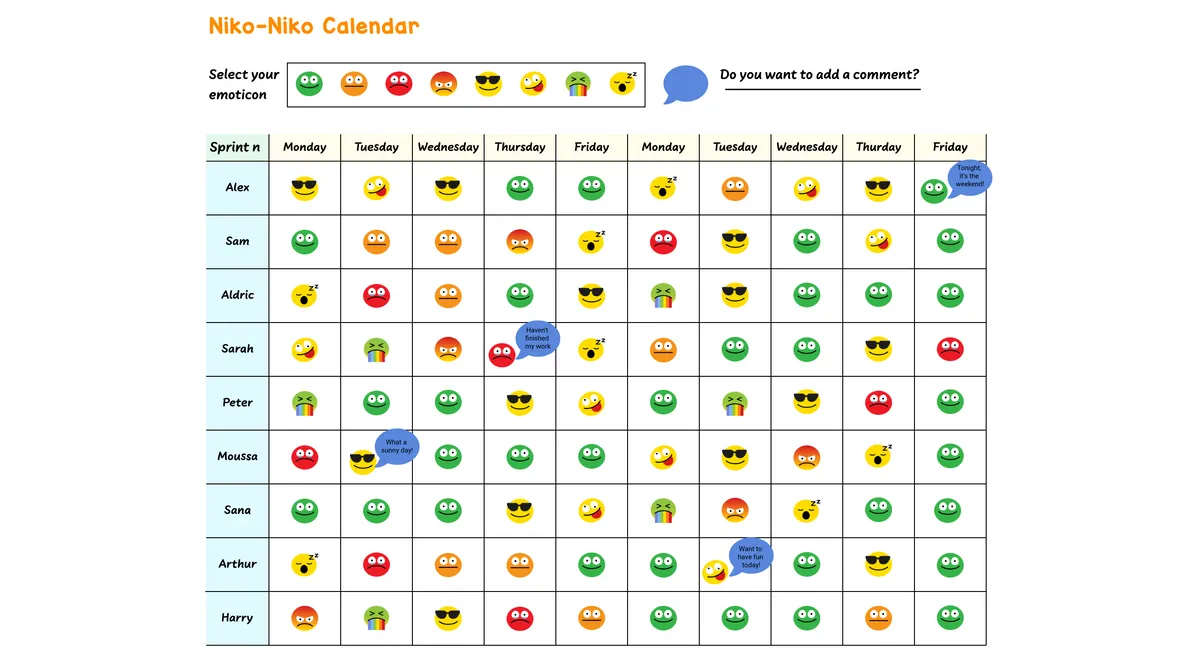What is the Niko Niko Calendar?
The Niko Niko Calendar is an agile management tool that visually exposing a team's mood and performance. "Niko" is an onomatopoeia that describes a "smile" in Japanese. Proposed in 2006 by Akinori Sakata, it displays the state of mind of the development team, creating a direct correlation between its mental and physical health and the conduct of the project. By providing the project manager with daily visual data, the calendar considerably reduces the time of feedback loops to improve or correct the team's operation.
The Niko Niko Calendar is a simple and effective method to verify team members' state of mind and mood during a sprint. It measures two subjective but fundamental elements in the conduct of projects: the motivation of the team and its well-being. The more green indicators, the better the current project is carried out. Conversely, the Niko Niko calendar makes it possible to link certain failures in the project's management and the team members' moods.
The significant advantage of the calendar is the speed of the feedback it provides: trends are taking shape in just a few days for the entire team or some of its members. Managers, HR, or Scrum Masters officials have a quick overview of their teams' state of mind and mood. They can identify the origin of frustrations or frustrations, associate them with the other sprint events, and provide support and solutions when the situation requires it.
The problems are detected quickly – they are sometimes even detected upstream, thanks to the predictive characters that are the emotions of the project team – and the conduct of the project as a whole is fluidified. To synthesize, the Niko Niko Calendar provides project managers with an effective tool to quickly react to problems and maintain the well-being and productivity of their teams at the best level.
How to put it in place?
The Niko Niko Calendar has the form of a table with a linear entry for each member of the team and a column per day of the week. At the end of their working day, everyone indicates how this day took place for them, using the visual code of the calendar.
This code is traditionally composed of a smiley and/or a colorful round:
- A smiling smiley, green, for example, testifies to a fluid day;
- A neutral smiley, orange, signals some hollows;
- An angry, red smiley is the sign of more severe complications;
- A sad, blue smiley can mean frustration.
When it is relevant, a sticky can be attached to the mood of the day to describe the underlying reason: a complication in the project or a communication problem, for example. The explanation allows the project manager to quickly understand the origin of the problem and, therefore, to deal with it more promptly.
The team regularly meets to debrief the data collected on the calendar. A negative smiley's tendency signals the team to reorganize and reflect on corrective solutions. The data analyzed can also reveal problems that don't involve the development in the sprint itself and only concern the team's functioning or even the personal problems of certain members.
The Niko Niko calendar does not work like the Mood Board: if one of the team members does not update their mood, it is not automatically considered identical to the day before. The interest of the calendar is to give the team a way to regulate its own functioning, in addition to the very conduct of the project.
